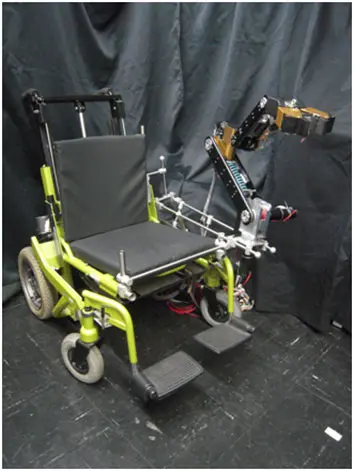Wheel chair robot project
Research Theme
A wheelchair mounted robotic arm (WMRA) has been developed in an attempt to provide assistance for its potential users in daily living activities. The research concerns include an assistive robotic arm, an operating interface, and intelligent manipulation algorithms.
Research Overview
Assistive technology has revealed its great importance in modern society, namely for its use in helping the elderly and disabled to perform functions in daily living activities that might otherwise be difficult or impossible. A wheelchair mounted robotic arm (WMRA) is a kind of assistive robot that combines a powered wheelchair used for mobility assistance with an assistive robotic arm mounted on the wheelchair for manipulation assistance. In this research, we are working on developing a WMRA system that can be used to help individuals with physical disabilities to recover some independence in their daily living activities such as accomplishing the tasks of “picking up an object on the floor,” “bringing a drink to the user’s mouth,” “opening doors,” and “scratching an itch.” The main objectives in this research include designing a compact, risk-free, assistive robotic arm that also has good functionality, designing an innovative operating interface that can be used to relieve the physical and cognitive burden of users interacting with it, and developing intelligent manipulation algorithms based on robot perceptions.
Compact, risk-free assistive robotic arm with high functionality
Several specific requirements need to be satisfied in designing an assistive robotic arm in order to deploy it in real living workspaces and environments that are always shared with human beings. For example, the assistive robotic arm must be safe and risk-free in order to be deployed in the vicinity of human beings; the functionality must be sufficient to accomplish different tasks; it must be compact in order to be mounted on a wheelchair and to work in an indoor environment; and the price must also be reasonable for its potential users.
We have adopted a seven-degree-of-freedom configuration in our design in order to provide good functionality and compactness. A mechanism for mechanical gravity compensation has also been introduced in an attempt to achieve a lightweight design. The assistive robotic arm mounted on the wheelchair is depicted in Fig. 1.

Intelligent robot manipulation based on arm navigation
Different computation algorithms such as the high performance IK solver, motion planning algorithms, and task planning algorithms are regarded as essential elements for robot manipulation. A novel arm navigation system has been set up based on the computation algorithms we developed. High-level task description can be fed to the novel arm navigation system and then executed in a transparent way, whereas the arm navigation algorithm itself will take care of all the planning details regarding task specifications and environment conditions without the user having to be concerned about them.
The arm navigation system was implemented with the software platform “OpenVR.” OpenVR is a software tool that can construct a virtual robot and its working environment from CAD source files and point cloud data. The virtual robot can be operated the same as a real robot by providing corresponding controller and sensor interfaces, and it thus contributes to robotics research in concept visualization, robot design, algorithm development, and system integration. We developed and integrated the algorithms for arm navigation in a generalized way within OpenVR. The working environment of our WMRA system within OpenVR is shown in Fig. 2.

Intuitive operating interface
An innovative operating interface that not only can be used by individuals with severe physical disabilities, but can also be operated in an intuitive way, is another objective of our research.
Robot perception based on 3D camera
Autonomous robots need to have an understanding of the surrounding environment. Research on robot perception that makes use of a 3D camera to investigate information about the environment is another area we plan to pursue.
Outcomes and Presentations (Conference Presentations, Publications, etc.)
International Conference
- Wei WANG, Zeming ZHANG, Yuki SUGA, Hiroyasu IWATA, Shigeki SUGANO, “Intuitive Operation of A Wheelchair Mounted Robotic Arm for The Upper Limb Disabled: The Mouth-only Approach”, Proceeding of IEEE International Conference on Robotics and Biomimetics (ROBIO’12), pp.1733-1740, 2012.
- Wei WANG, Yuki SUGA, Hiroyasu IWATA, Shigeki SUGANO, “Solve Inverse Kinematics Through A New Quadratic Minimization Technique”, Proceeding of the 2012 IEEE/ASME International Conference on Advanced Intelligent Mechatronics (AIM’12), pp.306-313, 2012.
- Wei WANG, Yuki SUGA, Hiroyasu IWATA, Shigeki SUGANO. “OpenVR: A Software Tool Contributes to Research of Robotics”, In 2011 IEEE/SICE International Symposium on System Integration, December 20-22, 2011, Kyoto, Japan.
- Wei WANG, Yuki SUGA, Shigeki SUGANO, “Contact Detection and Reaction of a Wheelchair Mounted Robotic Arm Equiped with Mechanical Gravity Canceller”, in The 2010 IEEE/RSJ International Conference on Intelligent Robots and Systems, October 18-22, 2010, Taipei, Taiwan.
- Wei WANG, Yuki SUGA, Shigeki SUGANO, “Task Execution of a Wheelchair Mounted Robotic Arm incorporated with Active Compliance Control”, in SICE Annual Conference 2010, August 18-21, 2010, Taipei, Taiwan.
- Wei WANG, Yuki SUGA, Shigeki SUGANO, “Task Execution Support of a Wheelchair Mounted Robotic Arm in Activity of Daily Livings”, in The 2010 IEEE/ASME International Conference on Advanced Intelligent Mechatronics Montr?al, Canada, July 6-9, 2010.
- Wei WANG, Yuki SUGA, Shigeki SUGANO, “Human in Loop Integration of An Arm Mounted Wheelchair Robot Based on RT Middleware”, in 41th International Symposium on Robotics (ISR2010), Munich, Germany, June, 2010.
Domestic Conference
- Wei WANG, Yuki NISHI, Yuki SUGA, Shigeki SUGANO, “Human-in-loop Integration of a Wheelchair Mounted Robotic Arm through Brain Machine Interface”, in the 2010 JSME Conference on Robotics and Mechatronics (ROBOMEC2010), paper no.1A2-F09, Asakikawa, Japan, June, 2010.
Past members
- Zheming ZHANG
- Yuki MATSUO
- Yuki NISHI